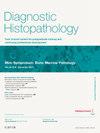乳腺浸润性上皮增生:罕见复杂硬化病变1例报告
引用次数: 0
摘要
乳腺浸润性上皮增生(IE)是一种复杂的硬化性病变,在常规诊断实践中并不常见。组织学上,所有病例均表现为常见的红润导管增生样增生,伴不规则上皮灶浸润相邻的硬化弹性间质。由于其浸润性生长模式和肌上皮细胞的局灶性损失,IE很容易被误诊为浸润性癌。大多数病理学家将IE归类为放射状瘢痕/复杂硬化(RS/CSL)。虽然已发现与致癌PIK3突变的关联,但其作为肿瘤增殖的倾向仍不确定。目前认为这是一种需要完全切除的华丽增生实体。鉴于其罕见性和误诊的可能性,认识到IE的细微但独特的特征是至关重要的。需要进一步的研究来阐明其行为、与癌症的关系及其作为前驱病变的潜力。本文章由计算机程序翻译,如有差异,请以英文原文为准。
Infiltrating epitheliosis of the breast: a case report on an uncommon and challenging complex sclerosing lesion
Infiltrating epitheliosis (IE) of the breast is a complex sclerosing lesion uncommonly encountered in routine diagnostic practice. Histologically, all cases demonstrate florid usual ductal hyperplasia-like proliferation with irregular epithelial foci that appear to infiltrate into the adjacent scleroelastotic stroma. IE can easily be misdiagnosed as invasive carcinoma due to its infiltrative growth pattern and focal loss of myoepithelial cells. Most pathologists classify IE in the radial scar/complex sclerosing (RS/CSL) spectrum. Although association with oncogenic PIK3 mutations has been found, its propensity to behave as a neoplastic proliferation is still uncertain. It is currently considered a florid hyperplastic entity requiring a complete excision. Given its rarity and potential for misdiagnosis, recognising the subtle but distinctive features of IE is essential. Further studies are needed to clarify its behaviour, association with carcinoma and its potential as a precursor lesion.
求助全文
通过发布文献求助,成功后即可免费获取论文全文。
去求助
来源期刊

Diagnostic Histopathology
Medicine-Pathology and Forensic Medicine
CiteScore
1.30
自引率
0.00%
发文量
64
期刊介绍:
This monthly review journal aims to provide the practising diagnostic pathologist and trainee pathologist with up-to-date reviews on histopathology and cytology and related technical advances. Each issue contains invited articles on a variety of topics from experts in the field and includes a mini-symposium exploring one subject in greater depth. Articles consist of system-based, disease-based reviews and advances in technology. They update the readers on day-to-day diagnostic work and keep them informed of important new developments. An additional feature is the short section devoted to hypotheses; these have been refereed. There is also a correspondence section.
 求助内容:
求助内容: 应助结果提醒方式:
应助结果提醒方式:


